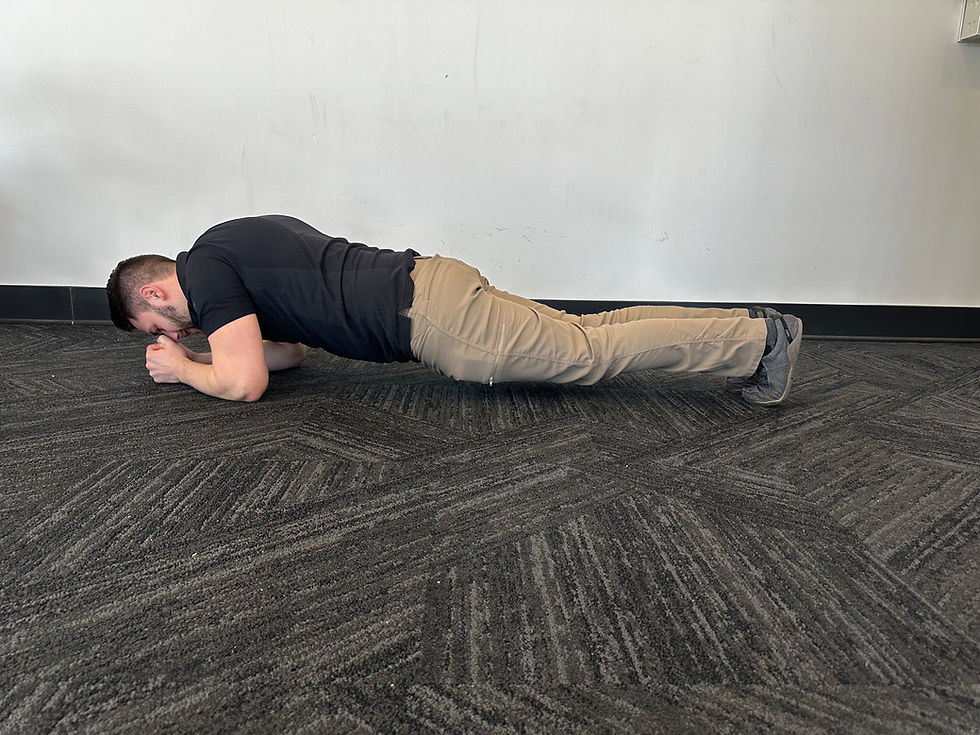Scapular Pull-Up Exercise
- Benjamin Mishleau
- Jan 22
- 3 min read
Updated: Mar 4
The scapular pull-up originated as a preparatory and corrective exercise within gymnastics, physical therapy, and strength training. Designed to isolate the movement of the scapulae (shoulder blades), it helps improve shoulder stability, strengthen the muscles of the upper back, and refine pulling mechanics. The exercise gained popularity as coaches and therapists recognized its value in preventing shoulder injuries and improving performance in pull-ups, climbing, and other overhead activities. By focusing on controlled, small movements, the scapular pull-up enhances mind-muscle connection and builds a foundation for more advanced pulling exercises, making it a staple in functional fitness and rehabilitation routines.
Purpose: Strengthen the muscles around the scapula (shoulder blades) and improve shoulder stability.
Targeted Areas: Lower trapezius, rhomboids, serratus anterior, and latissimus dorsi
Instructions:
Begin by hanging from a pull-up bar with an overhand grip, hands slightly wider than shoulder-width apart. Your arms should be fully extended, and your body relaxed.
Engage your core to stabilize your body and avoid swaying.
Without bending your elbows, pull your shoulder blades down and together, as if trying to pinch them behind you. Your body should slightly rise as your scapula moves.
Hold the contraction for 1–2 seconds at the top.
Slowly release the tension in your shoulder blades to return to the starting position with control.
Perform 5–10 repetitions for 2–3 sets.
Tips:
Focus on initiating the movement with your scapula, not your arms, to ensure proper activation of the target muscles.
Keep your shoulders away from your ears throughout the exercise to avoid shrugging.
Avoid swinging or using momentum; maintain a controlled and deliberate motion.
Who Should Do the Scapular Pull-Up?
The scapular pull-up is a great exercise for strengthening the muscles around the shoulder blades, particularly the upper back and traps. It is ideal for:
Athletes & Strength Athletes: Ideal for those who need to improve scapular control and strength, which is essential for pull-ups, muscle-ups, and other upper-body exercises.
People with Shoulder Stability Issues: This exercise helps improve shoulder stability by engaging the muscles that control the scapula. It can be beneficial for people working on shoulder rehabilitation or prehab.
Individuals Looking to Improve Pull-Up Form: Those looking to improve their ability to perform full pull-ups or chin-ups can benefit from scapular pull-ups as a foundational exercise to develop the scapular strength required for the movement.
People with Poor Posture or Upper Back Weakness: Scapular pull-ups are excellent for improving posture and strengthening the upper back and shoulder girdle, which can alleviate tension caused by poor posture or sedentary habits.
Those Working on Shoulder Health and Mobility: This exercise helps with the mobility and movement of the scapula, making it beneficial for people who experience limited range of motion or discomfort in the shoulders.
Who Should Avoid or Modify the Scapular Pull-Up?
While the scapular pull-up is beneficial for many, some individuals may need to modify or avoid it due to specific conditions:
People with Severe Shoulder Injuries: If you have a rotator cuff tear, shoulder impingement, or other significant shoulder injuries, the scapular pull-up could aggravate the condition, especially if the muscles around the shoulder are weak or underdeveloped. Modification or avoidance might be necessary for those with severe shoulder pain or instability.
Individuals with Elbow or Wrist Problems: Although the scapular pull-up targets the upper back and shoulders, the exercise involves grip strength, which could put stress on the elbows or wrists if there are existing issues (e.g., tendinitis or carpal tunnel syndrome). It may be better to modify the exercise or avoid it if elbow or wrist pain is present.
Beginners or Those New to Pull-Up Movements: For beginners or those new to strength training, performing the scapular pull-up without sufficient strength and stability might lead to improper form or unnecessary strain. Beginners should consider using assistance bands or practicing scapular retraction exercises on a machine before progressing to this movement.
Pregnant Women (Later Stages): The scapular pull-up may not be comfortable for pregnant women, especially as the body changes in later stages. Modifying the exercise or avoiding it during pregnancy is recommended, particularly if imbalance or discomfort occurs.
People with Limited Range of Motion in the Shoulders: Those with limited shoulder mobility or tightness may have difficulty performing scapular pull-ups properly, which could lead to compensatory movements or strain. Improving shoulder mobility through stretching and other exercises may be necessary before attempting this movement.
If It Causes Pain: If in doubt, if it causes pain, don't do it.









Comments